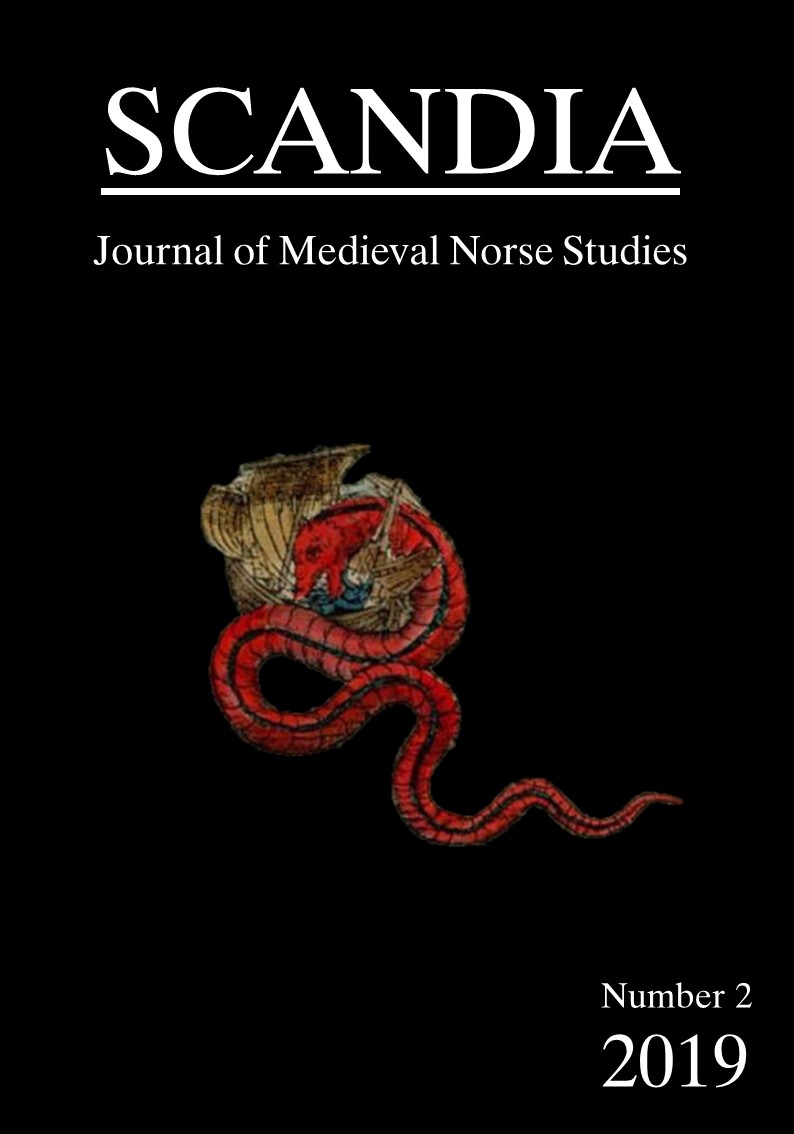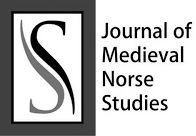La maledizione di Skírnir: studio e analisi
Abstract
Lo Skírnismál è uno dei dieci carmi mitologici presenti nella Ljóða Edda (“Edda Poetica”). Conosciuto anche con il nome di For Skírnis, il testo è databile tra il IX e il X secolo. Il carme narra la vicenda amorosa che intercorre tra il dio vanico Freyr e la gigantessa Gerðr. Scritto sotto forma dialogica, esso è dominato da una lunga maledizione in versi pronunciata da Skírnir, fedele servitore di Freyr, il quale se ne serve per forzare la fanciulla a concedersi al dio. Da un punto di vista contenutistico, la maledizione riecheggia molteplici temi già noti alla tradizione germanica antica, primo tra tutti quello dell’amore non corrisposto e del ricatto mediante incantesimi e minacce. In questo articolo si tenterà sia di evidenziare tali motivi e metterli a confronto con la tradizione culturale e letteraria germanica e non, sia di mettere in luce alcune particolarità stilistico-formali della maledizione, applicando a queste uno studio di tipo pragmalinguistico (teoria degli atti linguistici), che ne metta in evidenza il ruolo performativo.
Downloads
References
Bibliographical References:
Fonti Primarie – Primary Sources:
DOLFINI, Giorgio (a cura di), Snorri Sturluson Edda. Milano: Adelphi Edizioni, 2017.
FAULKES, Anthony. (ed.), Snorri Sturluson. Edda: Háttatal. Vikings Society for Northern Research. University College London, 2007.
NECKEL, Gustav. (hrsg), Edda: Die Lieder des Codex Regius nebst verwandten Denkmälern, I. Carl Winters Universitätsbuchhandlung, Heidelberg, (1914): 66-74.
SCARDIGLI, Piergiuseppe (a cura di), Il canzoniere Eddico. Milano: Garzanti, 2009.
Fonti Secondarie – Secondary Sources:
AGAMBEN, Giorgio. Il sacramento del linguaggio. Archeologia del giuramento. Bari: Sagittari Laterza, 2008.
ANDERSON, Philip N. Form and Content in Lokasenna: A Re-evaluation. In “The Poetic Edda. Essays on Old Norse Mythology” (ed. P. Acker and C. Larrington), (2002): 139-158.
AUSTIN, John L. How to do things with words. Oxford: Clarendon Press, 1962.
AUSTIN, John L. Enunciati performativi. In: “John L. Austin Saggi Filosofici” (ed. P. Leonardi, Guerini e Associati), Milano (1996): 221-236.
BETZ, Hans D. (ed.), The Greek Magical Papyri in translation including the Demotic Spells. Chicago/London: The University of Chicago Press, 1986.
BURTON RUSSELL, Jeffrey. Witchcraft in the Middle Ages. London: Cornell University Press, 1972.
BUZZONI, Marina. Il “genere” incantesimo nella tradizione anglosassone: aspetti semantico-pragmatici e sviluppo diacronico. Firenze: La Nuova Italia Editrice, 1996.
CAIANI, Lucia (a cura di), Etiche di Aristotele. Unione tipografico-editrice torinese, Torino (1996): 347-350.
CARDINI, Franco. Magia, stregoneria, superstizioni nell’Occidente medievale. Firenze: La Nuova Italia, 1979.
CHIESA ISNARI, Gianna. I miti nordici. Milano: Longanesi, 2016.
CIANCI, Eleonora. The Pervinca Charm: a Medieval German Love Charm. In: “Incantatio 7”, (ed. H. Passalis), Palgrave Macmillan, (2018): 94-131.
CLEASBY, Richard. An Icelandic-English Dictionary. Oxford, 1874.
COMETTA, Marina. L’uso della magia nel mondo germanico. Edizioni Unicopoli, 2013.
CRAWLEY, Alfred E. Cursing and Blessing. In: “Encyclopedia of Religion and Ethics IV” (ed. J. Hastings), Edinburgh (1981): 367-374.
DOLCETTI CORAZZA, Vittoria. Il ‘Maledire’ nei Carmi Eddici. In: “Lettura dell’Edda. Poesia e Prosa.” (ed. V. Dolcetti Corazza, R. Gendre), Bibliotecha Germanica, Edizioni Dell’Orso, Alessandria (2007): 115-144.
EBERT, Theodor. Praxis und Poiesis. Zu einer handlungstheoretischen Unterscheidung des Aristoteles. In: “Zeitschrift für philosophische Forschung, Bd. 30, H. 1”, Vittorio Klostermann (GmbH), (1976): 12-30.
HARRIS, Joseph. Cursing with the thistle. ‘Skírnismal’31, 6-8 and OE Metrical Charm 9, 16-17. In: “Neuphilologische Mitteilungen, Vol. 76, No. 1”, Modern Language Society (1975): 26-33.
KIECKHEFER, Richard. European Witch Trials. Their foundations in Popular and Learned Culture, 1300-1500. Oxon/New York: Routledge, 2011.
KUUSELA, Tommy. ‘Med trehövdad turs skall du leva’: sexuellt betvingande trolldom I norisk mytologi och religion. In: “Chaos 62, II”, Chaos & Forlaget Chaos (2014): 41–74.
LARRINGTON, Carolyne. “What does woman want?” Mær and munr in Skírnismál. In: “Álvíssmál 1” (1993): 3-16.
LOZZI GALLO, Lorenzo. The Giantess as Foster-Mother in Old Norse Literature. In: “Scandinavian Studies, vol. 78”, University of Illinois Press (2006): 1-20.
MITCHELL, Stephen A. För Scírnis as Mythological Model: frið at kaupa. Arkiv för mprdisk filologi 98, Lund University (1983): 108-122.
MITCHELL, Stephen A. Skírnismál and Nordic Charm Magic. In: “Reflections on Old Norse Myths. Viking and Medieval Scandinavia, Studies 1.” (ed. Hermann, Schjødt, Kristensen), Brepols (2007): 75-94.
PULSIANO, Phillip. Medieval Scandinavia an Encyclopedia. London & New York: Garland Publishing, 1993.
RADZIN, Hilda. Names in the Mythological Lay Skírnismál. In: “Literary Onomastics Studies, Vol. 12, No. 18”, St. John’s University, 1985.
http://digitalcommons.brokport.edu/los/vol12/issl/18.
REICHARDT, Konstantin. Die Liebesbeschwörung in Før Skírnis. In: “The Journal of English and Germanic Philology, Vol. 38, No. 4 (Oct. 1939)”, University of Illinois Press (1939): 481-495.
SCHULTE, Michael. Die Blekinger Runensteine als Machtembleme. Ein kulturischer und komparativer Syntheseversuch. In: “Beiträge zur Geschichte der deutschen Sprache und Literatur, 136” (hrsg. Haustein, Köbele, Nübling, Szczepaniak),
SCOVAZZI, Marco. Le origini del Diritto germanico: fonti, preistoria, diritto pubblico. Milano: Giuffrè, 1957.
SCOVAZZI, Marco. Il diritto islandese nella Landnámabok. Milano: Giuffrè, 1961.
VON SEE, Klaus von See et al. Kommentar zu den Liedern der Edda. Band II: Götterlieder – Skírnismál, Hárbarðslislióð, Hymiskviða, Lokasenna, Þrymskviða. Heidelberg, Universitätsverlag Winter, 1997.
STEINSLAND, Gro. Pagan Myths in Confrontation with Christianity: Skírnismál and Genesis. Scripta Instituti Donneriani Aboensis, 13 (1990): 316-328.
STORMS, Godfrid. Anglo-Saxon Magic. Springer-Science+Business Media, B.V., Nijmegen, 1948.
SUZUKI, Seiichi, The meters of Old Norse Eddic Poetry. De Gruyter, Berlin/Boston (2014):572-772.
VAN DIJK, Teun A. Studies in the Pragmatics of discourse. Pairs-New York: Mouton Publishers, 1981.
VOGT, Walther H. Fluch, Eid, Götter – altnordisches Recht. In: “Zeitschrift der Savigny-Stiftung für Rechtsgeschichte / Germanistische Abteilung” (hrsg. Haferkamp, Oestmann, Rückert) (1937): 1-57.
THORVALDSEN, Bernt Øyvid. The poetic curse and its relatives. In: “Along the oral-written continuum: types of texts, relations and their implications” (ed. S. Ranković, L. Melve, E. Mundal), Brepols, Belgium (2010): 253-267.
TOPORKOV, Andrei. Russian Love Charms in a Comparative Light. In: “Charms, Charmers and Charming: International Research on Verbal Charm”, (ed. J. Roper), Palgrave Macmillan (2009): 119-144.
WESTCOAT, Eirik. The Goals of galdralag: identifying the historical instances and uses of the metre. In: “Saga-Book vol. XL”, Viking Society for Northern Research, University College London (2016): 69-90.
Downloads
Published
Issue
Section
License
The author (s) of the original submitted undertake to comply with the following:
- All authors are publicly responsible for it.
- The authors claim that this original is their own and that they assume full responsibility to third parties, whether moral or patrimonial, by reason of its content, stating that the work does not infringe any intellectual property rights of third parties.
- The author (s) agree to the copyrights of the original to Scandia Journal, to which they grant permission for its reproduction, editing and online publication.
- The author (s) grant their copyright of their original to the Scandia Journal, licensed under the Creative Commons Attribution License, which allows the sharing of this work with the acknowledgment of their authorship.
- The author (s) have permission and are encouraged to cite and distribute their original.



